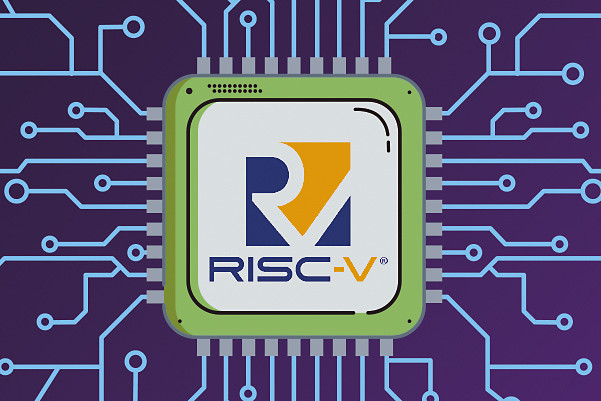RISC-V (pronounced “risk-five”) is an open standard instruction set architecture (ISA) based on the reduced instruction set computing (RISC) principles. Unlike proprietary ISAs such as x86 or Arm, RISC-V is openly specified and freely available, allowing anyone to design, manufacture, and commercialize RISC-V processors without licensing fees or royalties.
RISC-V is rapidly emerging as a major force in the semiconductor industry, with adoption across AI, automotive, edge, embedded systems, consumer electronics, and even supercomputers. It has become a strategic alternative in a market traditionally dominated by Intel (x86) and Arm.
Overview
-
ISA Type: Load-store, RISC
-
Word Sizes: 32-bit, 64-bit, 128-bit
-
License: Open and royalty-free
-
Standardized by: RISC-V International (nonprofit governing body)
-
First released: 2010 (University of California, Berkeley)
RISC-V provides a modular ISA, allowing users to implement only the functionality they need—such as integer-only cores for embedded systems or vector processors for HPC.
History and Development
Origins at UC Berkeley
RISC-V was developed in 2010 by researchers at the University of California, Berkeley, including Krste Asanović, David Patterson, and others. It was designed as a teaching ISA that could be implemented in academic and industry settings without legal encumbrances.
Key motivations included:
-
Avoiding proprietary ISAs (x86, Arm, MIPS) that were closed or expensive
-
Creating a clean, modular RISC ISA for modern design needs
-
Promoting open innovation and reproducible research
Open-Source Philosophy
Unlike past ISAs, RISC-V is fully open-source in its specification. Anyone can:
-
Build their own RISC-V core
-
Contribute to the evolving standard
-
Use and modify implementations without IP restrictions
Key Features
| Feature | Description |
|---|---|
| Modular ISA | Base integer ISA (RV32I/RV64I) with optional extensions |
| Open Specification | No licensing required to implement |
| Scalable Design | Suitable for MCUs, edge devices, desktops, and supercomputers |
| Custom Extensions | Users can define proprietary instructions on top of the base |
| Community-Driven | Maintained and governed by RISC-V International |
| Toolchain Support | GCC, LLVM, QEMU, Linux, Zephyr, and many more |
| Security Focused | Includes standard cryptographic and isolation extensions |
ISA Architecture
Base ISAs
-
RV32I – 32-bit base ISA
-
RV64I – 64-bit base ISA
-
RV128I – 128-bit base (less commonly implemented)
Standard Extensions
-
M – Integer multiplication and division
-
A – Atomic instructions
-
F/D – Single/Double-precision floating point
-
C – Compressed instructions (16-bit)
-
V – Vector extension (for SIMD, AI, HPC)
-
H – Hypervisor support
-
S/U – Supervisor and User privilege levels
-
Zk – Cryptographic extensions (Zk*, Zkn, Zks, etc.)
Custom Extensions
-
Designers can add custom instructions (X-extension) without conflict with standard ISA rules.
Governance: RISC-V International
Formed in 2020, RISC-V International is a nonprofit organization based in Switzerland, responsible for managing the ISA and ensuring open development.
Members include:
-
Founding and Premier Members: Google, Intel, Qualcomm, NVIDIA, SiFive, Andes, Alibaba, Huawei, Samsung, and more
-
Over 3,000 members globally
-
Technical Working Groups (TWGs) oversee specific ISA extensions and specs
Hardware Implementations
RISC-V processors are available from commercial vendors, startups, and open-source projects:
Notable Cores
| Company / Project | Core | Type |
|---|---|---|
| SiFive | U7, X280 | Application and AI |
| Andes Technology | AX45MP, NX27V | Embedded to high-performance |
| Codasip | Bk series | Configurable embedded cores |
| Intel | Nios V | Embedded soft-core using RISC-V |
| Alibaba T-Head | Xuantie | SoCs for IoT and AI |
| Tenstorrent | Custom RISC-V | AI chiplets |
| Esperanto | ET-SoC-1 | 1000-core AI processor |
| StarFive | JH7110 | Linux-capable SoC for edge |
Open-Source Cores
-
Rocket (Berkeley)
-
BOOM (Out-of-order)
-
CV32E40P (formerly PULP RI5CY)
-
OpenHW Group projects (CORE-V)
-
Shakti (India)
Software Ecosystem
RISC-V benefits from a rapidly growing open-source software stack:
-
Toolchains: GCC, LLVM/Clang, Binutils
-
Operating Systems:
-
Linux (including Debian, Fedora, OpenSUSE)
-
RTOSes: Zephyr, FreeRTOS, RIOT
-
-
Virtualization: QEMU, KVM
-
Debugging: GDB, OpenOCD
-
Security: Trusted Firmware, Keystone (TEE), OpenTitan
-
Compilers and Runtimes: Rust, Go, Java, Python (Micropython)
Use Cases and Applications
RISC-V is being adopted across a wide range of industries:
Embedded and IoT
-
Microcontrollers, sensors, smart home, wearables
-
Ultra-low power and cost-efficient cores
Automotive
-
ADAS, ECUs, in-cabin systems, safety MCUs
-
Functional safety (ASIL-D), real-time control
AI and Machine Learning
-
AI accelerators and dataflow architectures using RISC-V control cores and vector extensions
Data Centers and HPC
-
RISC-V-based servers and accelerators (Esperanto, Ventana, Tenstorrent)
-
Custom chiplets for AI and cloud
Consumer Electronics
-
Smart TVs, audio, media processors
-
Often used for real-time subsystems or control cores
National Sovereignty / Strategic Computing
-
Countries like India, China, Russia, and the EU promote RISC-V for technology independence
-
Open architecture reduces reliance on foreign IP and export restrictions
Challenges and Limitations
Despite rapid growth, RISC-V still faces key challenges:
-
Software Maturity: While improving, still behind Arm/x86 for commercial-grade SDKs, drivers, and middleware
-
Ecosystem Fragmentation: Multiple vendors with diverse implementations and extensions
-
Performance Leadership: Lags behind Apple, AMD, Intel in peak performance cores
-
Toolchain Optimization: Needs more investment in compilers, debuggers, and profiling tools
However, these are actively being addressed through community and corporate investment.
Strategic Impact
RISC-V is increasingly viewed as a strategic asset in the global technology landscape:
-
Supports innovation at all levels (academia, startups, national labs)
-
Enables chiplet-based design, custom SoCs, and heterogeneous compute
-
Undermines closed ISA monopolies, encouraging competition and choice
Governments and large corporations are embracing RISC-V as part of industrial policy and supply chain resilience strategies.
Future Outlook
RISC-V is expected to:
-
Achieve performance parity with leading proprietary cores in the next 3–5 years
-
Become the de facto standard for embedded and configurable processors
-
Enable democratized hardware innovation via open-source silicon
Emerging areas include:
-
High-performance compute clusters
-
Secure enclaves and TEE
-
High-NA EUV-ready chiplets
-
AI/ML accelerators
-
Quantum control systems
Share this post via:













The Quantum Threat: Why Industrial Control Systems Must Be Ready and How PQShield Is Leading the Defense